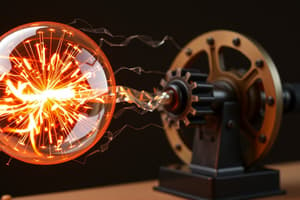Podcast
Questions and Answers
In what type of motion does the velocity change by equal amounts in equal time intervals?
In what type of motion does the velocity change by equal amounts in equal time intervals?
- Uniform acceleration (correct)
- Uniform motion
- Non-uniform acceleration
- Non-uniform motion
What is a characteristic of the velocity-time graph for all uniformly accelerated motions?
What is a characteristic of the velocity-time graph for all uniformly accelerated motions?
- It is a straight line (correct)
- It is sinusoidal
- It is a curve
- It is parabolic
In non-uniformly accelerated motions, how can the velocity-time graph vary?
In non-uniformly accelerated motions, how can the velocity-time graph vary?
- Sinusoidal shape
- Always a straight line
- Parabolic shape (correct)
- Triangle shape
What does the graph in figure 1.8 indicate about uniform acceleration in motion?
What does the graph in figure 1.8 indicate about uniform acceleration in motion?
What distinguishes the car's velocity in the given example from that of a train?
What distinguishes the car's velocity in the given example from that of a train?
How does the distance-time graph differ for uniform and non-uniform motion?
How does the distance-time graph differ for uniform and non-uniform motion?
What is the purpose of using nichrome wire XY in the experiment?
What is the purpose of using nichrome wire XY in the experiment?
In the experiment, what does the observation chart help in recording?
In the experiment, what does the observation chart help in recording?
Based on Ohm's Law, what happens to current when voltage is increased?
Based on Ohm's Law, what happens to current when voltage is increased?
What is the resistance of the conductor in the example provided with a potential difference of 24 V and current of 0.24 A?
What is the resistance of the conductor in the example provided with a potential difference of 24 V and current of 0.24 A?
In Example 3, what is given to calculate the current flowing through the filament of the light bulb?
In Example 3, what is given to calculate the current flowing through the filament of the light bulb?
What is determined by drawing a graph between current and potential difference in the experiment?
What is determined by drawing a graph between current and potential difference in the experiment?
What is the law of conservation of energy?
What is the law of conservation of energy?
How does energy transfer between the two pendulums in the provided experiment?
How does energy transfer between the two pendulums in the provided experiment?
What form of energy is present when an object is falling freely due to gravity?
What form of energy is present when an object is falling freely due to gravity?
In the provided diagram, what type of energy conversion is represented by the Secondary cell?
In the provided diagram, what type of energy conversion is represented by the Secondary cell?
What would happen to the energy level if the two pendulums in the experiment had different lengths?
What would happen to the energy level if the two pendulums in the experiment had different lengths?
What principle governs how energy transformations occur as per the provided text?
What principle governs how energy transformations occur as per the provided text?
In the context of the artificial satellite moving around the Earth in a circular orbit, why is the work done by the gravitational force considered zero?
In the context of the artificial satellite moving around the Earth in a circular orbit, why is the work done by the gravitational force considered zero?
What is the main objective of the National Physical Laboratory in New Delhi?
What is the main objective of the National Physical Laboratory in New Delhi?
If Pravin applies a force of 100 N at an angle of 60 degrees to take an object of mass 20 kg to a height of 10 m horizontally, what is the work done?
If Pravin applies a force of 100 N at an angle of 60 degrees to take an object of mass 20 kg to a height of 10 m horizontally, what is the work done?
How is work related to displacement in the context of Pravin's applied force?
How is work related to displacement in the context of Pravin's applied force?
What is the relationship between the applied force and the displacement when work is calculated?
What is the relationship between the applied force and the displacement when work is calculated?
In what scenario would the work done by a force be zero?
In what scenario would the work done by a force be zero?
What is the resistivity of the material of the conducting wire in Example 2?
What is the resistivity of the material of the conducting wire in Example 2?
What is the current flowing through the appliance in Example 4?
What is the current flowing through the appliance in Example 4?
How much potential difference should be applied across the two ends of the appliance with a resistance of 500 W in Example 4?
How much potential difference should be applied across the two ends of the appliance with a resistance of 500 W in Example 4?
What is the resistance of the copper wire in Example 5?
What is the resistance of the copper wire in Example 5?
If the potential difference across an appliance is 25 V and the resistance is 50 W, what is the current flowing through it?
If the potential difference across an appliance is 25 V and the resistance is 50 W, what is the current flowing through it?
If a wire has a resistance of 20 W and a current of 5 A flowing through it, what is the voltage across its ends?
If a wire has a resistance of 20 W and a current of 5 A flowing through it, what is the voltage across its ends?
Flashcards are hidden until you start studying




